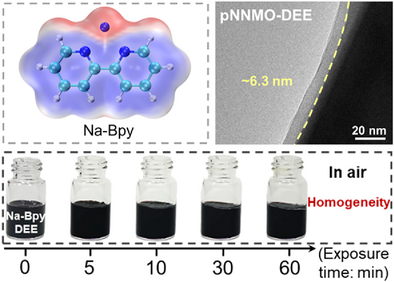Universal Chemical Presodiation Under Air Condition for Highly Stable Na-deficient Oxide Cathodes
Graphical Abstract
A universal chemical presodiation strategy using Na-Bpy/DEE is proposed for Na-deficient oxide cathodes under air condition, which promotes formation of uniform and robust NaF-rich interface during presodiation. This minimizes stress accumulation and structure distortion upon Na+ intercalation/extraction to exhibit high-capacity retention.
Abstract
Layered transition-metal oxides have attracted growing attention for sodium-ion batteries (SIBs); however, their application is hindered by low initial coulombic efficiency (ICE) due to Na-deficiency and solid-electrolyte interphase formation. Herein, a universal chemical presodiation pathway is reported with Na-bipyridine dissolved in diethyl ether (Na-Bpy/DEE) for stable Na-deficient P2-Na2/3Ni1/3Mn2/3O2 (NNMO) electrode under air condition. The strongly electron-withdrawing N-functional groups of Bpy•− radicals endow its air insensitivity, and it reduces the NNMO cathode for compensation of Na+ from the weakly solvating DEE. This results in a uniform and robust NaF-rich interface to prevent surface lattice disorder of NNMO, which is caused by local stress, and preserve structure integrity. The presodiated NNMO electrode shows high ICE of 100% and reversible capacity of 158.3 mAh g−1, and its pouch cell coupled with hard carbon presents high-capacity retention of 95.9% after 200 cycles. This work proposes an industrially feasible presodiation strategy to highly efficient SIBs.
Conflict of Interests
The authors declare no conflict of interest.
Open Research
Data Availability Statement
The data that support the findings of this study are available in the supplementary material of this article.





